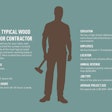

A year ago, "tentative" was the best word to describe the business atmosphere. Uncertainty about the economy and a war in Iraq put a damper on the business climate. Now, although struggles in Iraq continue and the economy is far from thriving, consumer confidence is returning. Most importantly for the hardwood flooring industry, the construction industry has remained strong. Housing starts for 2003 were at their highest rate in 25 years, at 1.848 million, and sales of new single-family homes topped one million units in 2003, establishing a new record high for the third consecutive year. Both were spurred by mortgage rates at rock-bottom lows (see charts, page 22).
This year, Hardwood Floors talked with contractors and dealers in the industry to find out how the economy has affected them and discover what the biggest challenges are. Many report that business this year is better than it has been in recent memory, but they find they have to work harder to succeed than they did during the wood flooring boom of just a few years ago. On a daily basis, they're confronting increased competition—from more wood flooring outlets to a slew of new woodflooring "expert" installers. Consumers are focused on getting a bargain,and leagues of installers are focused on getting the business, making for cut-throat pricing wars in some areas. At the same time, a host of factors have combined to decrease strip flooring supplies and increase material costs. In this climate, dealers and contractors must have a smart business strategy and position themselves wisely to grow and prosper in the future.
At What Cost?
Contractors and dealers report that the drastic increase in prices for their materials, specifically for red oak and white oak flooring, is their No. 1 concern. (See "The Lumber Crunch" sidebar on page 26.) Plywood prices have spiked, as well. Not surprisingly, these products also are frequently in short supply. At some points during the past year, prices went up so quickly that contractors had a difficult time guaranteeing the prices on their bids.
"I've had to swallow a few bids to oblige the price I gave and then makeup the difference out of my own pocket," says Ed Anderson, owner of Anderson Hardwood Floors LLC in Twin Cities suburb Lakeville, Minn. "When it gets to be a thousand square feet or more, it adds up." Anderson's market is dominated by traditional oak strip, which makes up the majority of his business. He has passed along the price increases to his customers, and while he's still busy due to steady word-of-mouth referrals, he feels the price increases are beginning to affect his business. "I don't think I'm getting all the jobs that I could if the price were a little more civilized," he says.
The price and supply squeeze for oak flooring has led to a boost in other flooring options. "There were times last spring when I couldn't get select white oak; I couldn't even find it," says Danny Fulton, owner of DFE Construction Services in Doylestown, Ohio. "So of course, when that's happening, I'm steering them towards hickory because I can get it." He's installing an increasing amount of maple, as well. "People always shop with their pocketbooks. Once it gets to the point where I can get hickory for a couple hundred dollars more, they tend to do that," he explains.
Alternative domestic species aren't the only species getting a boost from the increasing oak prices. Imports also are becoming more common. Contractors report that Brazilian cherry in particular is readily available at attractive pricing.
"Exotics, especially from Brazil, are giving great value," says Kevin Evans, president of Rock Solid Hardwoods in Denver. "We can install,sand and finish select-grade Brazilian cherry right now for less than we can No. 1 common red oak, so we are selling a lot of Brazilian cherry."
At Boatright Hardwood Floors in Austin, Texas, Owner Sam Boatright isn't too concerned about the short supply of oak flooring, because he has geared his business toward alternative looks. "Down here, in high-end houses, regular oak is a tired look; they don't go for it as much as they used to," he says. "That's why we use lots of species, wide plank, long plank, hand-scraped floors and patterned floors."
For the many contractors who install vast amounts of plywood for subfloors, both prices and supply have been an issue. At Enmar Hardwood Flooring in Mesa, Ariz., Treasurer Tricia Thompson says that has been a problem, especially during their busy summer months booked with gym installations. "We had three or four installs during the summer, and it was very tricky getting that amount of plywood," she says. "I had to order much sooner than I did before." She adds that running to the local big-box store for a few extra sheets often wasn't a reliable option,because even those stores were frequently out.

Direct from the Source
Up in Porter, Ind., at Hultman Flooring Inc., Owner Dean Hultman says his customers are choosing a variety of species that are suddenly at the same price points as traditional oak flooring. At the same time, however, "We're beating the bushes harder to get a better price for us on our materials," he says. His efforts include working with various distributors to see what terms he can get, as well as trying to deal directly with wood flooring mills. While many contractors remain committed to purchasing exclusively from distributors,surprising numbers of contractors of all business sizes and from all regions report that they are turning to direct business from mills, and discovering that their customers are, too.
"Typical models in the industry of the supply chain for everything from materials and labor to aftermarket service …the whole thing has changed dramatically," Rock Solid's Evans says. Instead of focusing on dealer-type companies such as his, Evans says distributors are catering to the "man-in-the-van" customer. To combat the lack of advantageous pricing, he has begun to deal more directly with suppliers in order to maintain good margins.
At Enmar, Thompson is pursuing direct purchasing, as well, for several reasons. She says she likes having a direct connection to the mill instead of having to go through a distributor in case there are problems with the products. In addition, she says it's hard to compete with the cut-throat pricing inherent to the Phoenix market. "To keep it competitive out here, it behooves me to buy direct, and I notice more and more people are allowing that to happen, as opposed to a couple years ago when I couldn't get anybody to do that," she says. She adds that she can purchase wood flooring job by job without the obligation of buying a whole truckload. Other contractors report that their suppliers require a truckload to sell direct.
These situations are emblematic of a supply system that's not as structured as it has been in recent memory. "It's a gray area how the relationship works between mills and distributors, because my distributor will sell to me, but I can't buy from his mills. At the same time, he will sell to somebody walking in the front door of his store with practically the same pricing that he gives me,"Hultman says. "I had the embarrassment of them underselling me on the same material to a customer who called me to do the installation."
Self-Service?
Contractors are finding a surge in the number of potential customers who are doing just that—buying their own wood and trying to hire wood flooring professionals to install it for them. The wood comes from any number of sources, whether it's a big-box store, liquidator type company, local mill or Web site.
"I think one of the biggest challenges is a lot of people selling direct via the Internet and people buying their own wood," Boatright says. Although many contractors assume such wood is inferior,he finds that's not always the case. "There are even high-end companies that sell direct to anyone," he adds. Boatright says he gets calls every day asking the company to install flooring that customers bought somewhere else, which his company does not do.
Likewise, Genia Smith, owner at Accent Hardwood Flooring Inc. in Durham, N.C., notices a trend of homeowners buying their own wood, and she uses a simple phone conversation to avoid installing it. "Our work is not cheap by any means … I'll give prices over the phone, but I never get any of the work," she says. "That's why I do it over the phone, so I don't waste my time."
Gary Barnum, owner at Barnum Quality Hardwood Floors in Des Moines, Iowa, frequently notices advertisements in his area newspapers that offer bargain prices on wood flooring. Like Boatright, he's wary. "I don't know how many rainstorms it's been in or where it's been," he says. His company will install flooring customers have bought elsewhere, but Barnum first asks to see a large sample of the wood before agreeing to it, and he charges accordingly. "I just bump my numbers up on the sanding end of it, so they're better off just getting it here in the first place," he explains.
In the northern woods of Minnesota, John McDonald, president of John McDonald & Sons Inc. in Bemidji, Minn., says customers are lured to buy wood flooring direct from the many local mills, whether it's through Yellow Pages ads, pamphlets or ads in the local newspaper. While the wood flooring is much cheaper, McDonald usually avoids using it himself, because "usually the quality is not up to par. It isn't end-matched, and you'll have to cut ends, knot holes, planer chips and things like that. I don't like working with that, but people think they're getting a good deal. In some cases, it's half the price." For the majority of his own flooring, McDonald sticks to buying from his distributors.
Professional hardwood flooring dealers and contractors also get calls from customers who bought flooring and intended to install it themselves, but then find themselves in a jam as the installation turns out to be more complicated than they anticipated. Rock Solid tries to turn these situations into an opportunity for the company, which encourages DIY business. "Instead of making them mad and saying, 'You bought it there, ask them!' we'll just cast seeds of doubt over who they purchased the wood flooring through—for example, 'They didn't tell you that you need to acclimate that? They didn't tell you you need a special nailer?'" Evans explains. For DIY business, the company also promotes a special package in which customers buy an hour or two of a Rock Solid installer's time to help get them started on the project. Oftentimes, the homeowners discover it's more difficult than they planned, and they simply hire Rock Solid to do the rest of the installation.
While many consumers buy their wood at big-box stores, the stores still don't seem to have made the impact on the professional wood flooring business that had been feared. The selection of wood flooring at most of these stores remains limited, and the companies have yet to make inroads in most markets to threaten independent wood flooring installers. Many contractors also mention that they avoid buying their wood flooring there.
DFE's Fulton says that in his area,flooring from big boxes has a bad reputation due to issues such as moisture content. "In our local area, it has a stigma," he says. "There are horror stories from contractors who installed it."
In the Twin Cities area, McDonald says one huge contractor handles all the installation work for one of the big box stores, from windows to cabinets. He received a call from the company more than a year ago asking if he would be interested in installing unfinished wood flooring for them. He's never heard back, however, and he hasn't seen the company pursue that type of business any further.
In the Denver market, Evans says that the big boxes' labor prices run about twice those of his company's. He believes the big boxes are an advantage for the wood flooring industry. "We see them as increasing the awareness of floor covering and giving us more options to compete with them, especially with wood flooring," he says.
Elbow-to-Elbow
As dealers and contractors attempt to cope with the higher prices and new market challenges, they find that their areas are increasingly crowded with competitors. The healthy construction industry and booming wood flooring business in recent years have attracted a steady influx of wood flooring contractors, making for an intensely competitive market.
In the Edmonton, Alberta, area, longtime contractor David Pillott, owner/operator of Edmonton Hardwood Floors, says there is an unprecedented, overwhelming number of wood flooring contractors and dealers flooding the market. "I had three guys phone me this morning. They worked for three different contractors,and they all were looking for employment," he says. "It's so saturated; it's spread too thin." In the booming market, everyone's employees started their own companies, he says. Now they're all competing with each other at rock-bottom prices, if they can get any business at all. "A guy who used to work for me five years ago now opened up a retail outlet. He went to Mexico on holiday for a month because he has no work," he says.
In Phoenix, Thompson says, "We see wood flooring companies come and go. You open up the phone book every year and you're like, "Who are these people?'" Usually, they go right out of business, she says. "That's the frustrating part for the consumer out here—if they want something from the company later, nine times out of 10 they're not available."
Oftentimes, these small one- or two man operations operate with little or no overhead on minimal margins. Established companies with employees, showrooms and substantial overhead costs must constantly prove themselves to justify their higher prices.
Sometimes, all it takes is a little patience. Marty Johnson, owner of Marty Johnson LLC in Seeley Lake, Mont., observes the same cycle in his area. "There are a few contractors who workout of their trucks and don't have insurance," he says. "They're tough to beat but usually don't last long. In a couple of years, they get burned, or they burn so many people that they get run out of town, so I've always kept my prices the same," he explains.
A good reputation is the best defense against intense competition, allowing some contractors to avoid the feeding frenzy at the lower price points. Some contractors even mention up front to customers on the phone that they won't be the cheapest bid, thereby filtering out customers looking for only low ball bids.
McDonald says he doesn't fight the price wars anymore. He's been in business for 15 years and relies on word-of mouth to get him jobs. "I know I have a good reputation, so I strive to maintain that. I've bid jobs against other contractors in the area when I was higher. People mention that, so the temptation is to say 'OK, I can do that, too.' I think I did that the first couple years I was in business, but I'm at a point now where if I'm 25 or 50 cents a foot higher, that's OK," he says.
Other companies try to target an entirely different sector of the market,staying away from bidding battles for strip flooring, focusing instead on exotic species, wide widths, hand-scraping and other custom floors.
"When I opened the business, I was the 11th company in wood flooring in the Yellow Pages; now there's probably 34, but we're kind of a niche market," says Kevin Mullany, president of Benchmark Wood Floors in Albuquerque, N.M. "We do work with high-end builders, interior designers, referrals from them and their friends,and that's where we stay. I can't compete with low price," Mullany says. "There are guys working out of their cars who will install strip for $5 per square foot installed, sanded and finished, so there's no sense in us going after that market."
Evans takes a similar attitude. "If people are selling by price, they aren't very good salespeople," he says. "Anybody can sell by price; it's the oldest way in the book to sell, but it's also the most deadly."
Need for Speed
Of course, working with builders is a mainstay of many wood flooring contractors and dealers, and some companies are finding that they have to change to maintain the builder connection. In many markets, the biggest change is the growing shift to prefinished flooring. Many builders find the quick turnaround times offered by prefinished wood floors irresistible.
DFE's Fulton says his work is split about evenly between unfinished and prefinished floors. "As of three years ago, I probably did all unfinished, but most of the builders I work for want prefinished, because it's quick and easy,"he says.
When it comes to Edmonton's builders, "I've never heard of a site-finished floor," Pillott says. "The builders are going in and buying thousands of square feet up and paying guys $1.70 or $1.50 (Canadian) a square foot to install it. They're getting a floor supplied and installed for $5 a square foot, and I'm up around the $9.50 or $10 mark—where am I going to go? It's really nuts here."
In some markets, builders are putting all the floor covering in the house into one bid. Two years ago, a large builder with which Benchmark Wood Floors had a long-standing relationship began asking for one bid for carpet, vinyl, tile and hardwood all together. Now, floor covering retailers are going after that market with aggressive margins. "Builders are being targeted by there tail stores who are going in with packaging," Mullany says. "I'm saying, 'You don't want a carpet man installing your wood floors; he doesn't know a thing about wood floors.'"
In the Raleigh, N.C., markets, some of the large tract builders have done the same thing, says Randy Hairfield, owner of Hairfield Floors Inc. in Richmond, Va. However, the builder market there is still firmly attached to site-finished floors, and the floor covering stores aren't interested. "Some of those big,big tract builders down here will let the bid out to one company for all floor covering, but then that company will hire a company like us to do all the wood," he explains. The floor covering companies aren't interested in getting into the wood business, he says. "The floor covering companies can't do what we do. They don't know how, and there isn't enough money in it for them to invest a lot of time and money to get a return for it. It's such a minimal gain for a pretty big expenditure," he says.
For both remodeling and new construction, the dividing line between unfinished flooring and prefinished flooring seems to be determined largely by the geographic market. Some regions are still dedicated to traditional, site-finished floors, while other regions have swung completely the other way.
In McDonald's northern Minnesota market, he anticipates having to install more prefinished floors in the future,but for now, he says, "There are enough people here who want unfinished floors—they call them 'the real thing.'"
Edmonton Hardwood Floor's Pillott still loves the craftsmanship of installing, sanding and finishing unfinished wood flooring, but he finds it a struggle to sell it in his market. "A lot of people phone me and say 'I'm interested in a hardwood floor.' I talk to them for awhile and find they don't even know what site-finished is," he laments. The only way he can get customers even to consider a site-finished floor is when he convinces them to look at his portfolio and see his custom work, he says.
Barnum gears his Iowa business toward high-end custom floors, but he does see customers choosing prefinished flooring as it's pushed by floor covering retailers alongside carpeting and other flooring. From a business standpoint, "The problem I have with prefinished floors is they have their own identity," he says. Instead of telling the neighbors it's a Barnum job, for example, they simply say it's a "Brand X" floor, he explains.
While many contractors still prefer traditional installing, sanding and finishing, others are attracted to the simple practicality of factory-finished flooring. Although her business caters to high end clients and specializes in custom work, "We're installing way more prefinished than we ever have," says Accent Hardwood Flooring's Smith. Prefinished flooring helps eliminate callback headaches, she says. "When you have a problem, it's rare that you have a problem with the installation. It doesn't bother me to skip the sanding and finishing," she explains.
Pillott worries that factory-finished flooring has taken over the market so swiftly that customers have no education about what they're buying. He tells a story about his wife encountering someone at the local dump who was throwing out a huge load of factory-finished flooring. She asked him if it was from a fire. "He said, 'No, it's just worn out.' She said, 'Why didn't you resand it?' He said, 'You can resand it?'" These days, refinishing is Pillott's mainstay. "I wish I could educate everybody," he says.
Down the Road
No matter what segment of the market they're targeting, hardwood flooring contractors and dealers are generally positive, if cautious, about the future. Most are hoping for a stabilization in material prices. If price increases don't slowdown, they worry that wood flooring will price itself out of consideration for many consumers. Laminate flooring, in particular, has gone so low in price that it has become an attractive option to many wood flooring consumers.
DFE's Fulton hasn't noticed the prices affecting his business yet, but "I've noticed that a lot of my builders that I work regularly for have cut back on the amount of hardwood they put in a typical home," he says. Typically, the homes had wood flooring in the foyer and dining room, as well as some kitchens and studies. "It seems like in the last six months, I'm just doing foyers. I think it's because builders have tight profit margins as it is, and they're trying to cut corners where they can." As prices continue to rise, he thinks more consumers will choose flooring such as vinyl, with wood flooring installation being a long-term instead of an immediate priority.
Contractors who rely on oak strip as their mainstay are especially concerned about the price increases. "My lifestyle isn't affected right now, but I wonder where it's going to end. Will it get to $4 for a square foot? I guess I'll have to attack business a little differently," Anderson says.
Overall, most are confident that the building market will remain strong as long as interest rates stay low in the near future. When building slows down, they anticipate a healthy remodeling and refinishing business. After an uncertain 2003, they now find consumers recovering their confidence in the economy.
"We're seeing houses that have been put on hold for a year coming back now for a bid, especially on high-end houses,"Boatright says. He says the continued low interest rates combined with better predictions for the economy are helping spur business. "In the last two months, I've had maybe 10 of those projects back on."
In Montana, Johnson is targeting exclusive trophy houses for his projects,and he says, "There's no end in sight … everybody's moving here." In Phoenix, Thompson says there is so much growth that one city even had to put a moratorium on building so that infrastructure such as roads and emergency services could catch up to the rapid new development.
Meanwhile, in Indiana, "Ever since the attack on 9/11, the economy really flattened out. We bumped along with some very dry winters as far as volumes of work," Hultman says. "Our calendar has not been so full for January and February for four years."
Despite the increased competition,higher price and bargain-hunting consumers, most contractor and dealer companies are finding a niche where they can succeed and expect to succeed for the future. As Boatright says, "It's just a little more challenging now than it used to be, and you just have to work smart."
Rest Insured?
Aperpetual concern for wood flooring contractors and dealers is how to attract and keep good employees. Besides healthy wages, an effective strategy is to offer generous benefits, especially health insurance, but companies are finding it increasingly difficult to afford, especially as they bid against one- or two-man operations who have little overhead and almost no markup. And, medical insurance is just the tip of the iceberg. In addition, there’s the obligatory workers comp (required by law in every state but Texas), liability insurance, auto insurance and sometimes more.
When the stock market was booming, experts say insurance rates were undervalued, because insurance companies were bolstered by their investments. As the stock market sagged and the insurance industry was hit by 9/11 claims, insurance rates have steadily climbed.
“One of my biggest concerns is, how do you keep good employees and keep a good benefits packagewhen it’s virtually unaffordable?” says Marty Johnson, owner of Marty Johnson LLC in Seeley Lake,Mont. Johnson’s concerns are echoed by contractors across the nation.
When she and her husband took over the family business, Tricia Thompson, treasurer at Mesa, Ariz.-based Enmar Hardwood Flooring added medical insurance for their employees, but “it’s been challenging,” she says. “The first couple years, you’re a small business and they give you thesedynamite rates. You go to renew it, and it’s two-and-a-half times what you were paying.” And, she adds, “We’re basically a healthy bunch of people.” She’s found that she has to comparison shop continually to find premiums that are affordable. Enmar covers 40 percent of its workers’ premiums.
To help cut costs, Genia Smith, owner of Accent Hardwood Flooring Inc. in Durham, N.C., dropped collision insurance on all of her company vans five or six years ago. “It was not worth it,” she says. “I have great liability coverage, but I won’t cover our work vans anymore. It isn’t worth it to me at all.” Each employer has to balance the value of the insurance against what the company can afford, especially as material costs rise and competitors lowball prices. It’s a delicate balance. Some choose to lower the percentage they cover or go to a plan with fewer benefits.
At Rock Solid Hardwoods in Denver, the company covers half the medical premiums for its employees, even if they have a family, but it’s a hard pill to swallow. “We want to be familyfriendly,”says Kevin Evans, president. “But there’s a lot of pressure in our industry, because everybody is looking for price, and that’s the holy grail.” —K.M.W.
The average annual premium cost for a single covered worker in 2003 was $3,383, of which the average employer contribution was $2,875. For families, the average cost was $9,068, of which theemployer contribution was $6,656. (Source: The Kaiser Family Foundation and the Health Research and Educational Trust)
In 2000, the average driver’s expenditure on auto insurance was $687. In 2004, it is estimated to be $898. (Sources: National Association of Insurance Commissioners, Insurance Information Institute)
In the 2003 NWFA Dealers and Contractors Employee Compensation Report, it was found that 94 percent of responding dealer/retailers offered medical insurance, as compared with 86 percent ofcontractors with a showroom and 68 percent of contractors without a showroom.
Between spring of 2002 and spring of 2003, monthly premiums for employer-sponsored health insurance rose 13.9 percent, the third consecutive year of double-digit premium increases, and the highest- premium increase since 1990. (Source: The Kaiser Family Foundation and the Health Research and Educational Trust)
Overall, workers comp rates have increased every year since 1999, making them comparable to workers comp rates in the early 1990s. (Source: Peter Burton, senior division executive for staterelations, NCCI Holdings Inc., Boca Raton, Fla.)
|
|
The Lumber Crunch
Contractors overwhelmingly responded in this year’s survey that they are concerned about rising material costs and supply. They express bewilderment at the continual wood flooring price increases, specifically for oak. A number of factors have combined to drastically increase the cost of red and white oak, which form the traditional backbone of the domestic wood flooring industry. They all come down to a simple fact, however—“There is a tremendous strain on the resource that the flooring industry depends upon,” says Judd Johnson, editor of Memphis, Tenn.-based Hardwood Market Report.
Industry experts look back to the year 2000 for the root of the cause. That’s when sawmill production began declining, caused in large part by the mass exodus of the American furnitureindustry to China. While there was still great demand for the lumber for wood flooring, the sawmills had fewer outlets where they could sell the higher lumber grades that usually went into furniture, and many went out of business.
Going into the end of 2002, wood flooring was oversupplied, creating low prices, even as manufacturers were paying more for their raw materials. As a result, solid wood production decreased. In addition, more manufacturers began using the lumber they could get for factory-finished wood flooring.
In the meantime, demand from other markets for the 2A lumber normally used for wood flooring hasgrown. A rebound in everything from truck trailer flooring to furniture frames has caused pressure on 2A lumber supply, and the furniture and cabinet industries have been using increasing amounts of 2A lumber to help offset their costs.
As the demand grew from all sectors of the market, weather was uncooperative. Rainfall that was almost twice the normal levels prevented loggers from going into the woods, further suppressing lumber supplies.
“The first three quarters of 2003 NOFMA [strip shipment] numbers failed to equal the previous year’s numbers, but it wasn’t because demand declined, it was because volume wasn’t there for manufacturers to ship,” Johnson explains. “Manufacturers were having to do unusual things—buy kiln-dried lumber and buy No. 1 common grade green and kiln-dried lumber. They have done so aggressively and are doing so today. Their lumber prices have escalated.”
With an improving economic climate and ceaseless demand, Johnson predicts the number of sawmills will increase as the weather improves. “Once things dry out and loggers can get back in the woods, it will be clearer if there are enough companies to respond to demand,” he says. —K.M.W.
Survey Says...
Last January, Hardwood Floors surveyed distributors and contractors to find out which types of products they use and what kind of business they did in 2003. Approximately 97 percent of contractors who responded specialized in wood flooring; while 88 percent of distributor respondents were wood flooring specialists. Here’s what they told us:
Contractors’ Business in 2003...
|
In 2002 ... • 46 percent of contractors indicated that business increased • 36 percent stayed the same • 18 percent decreased
|
Distributors' Business in 2003 ...
In 2002 ... • 66 percent of distributors indicated that business increased • 15 percent stayed the same • 19 percent decreased
|
Buying HabitsOf the contractors surveyed (more than one answer possible) ... 88% buy from specialty wood flooring distributors 28% buy from general floor covering distributors 27% buy from a big box store 26% buy direct from manufacturers At a big-box store, contractors say they are most likely to buy (in order of likelihood):
|
Feeling the Pain?Of the distributors surveyed... 59% said their business has been affected by big-box stores such as HomeDepot and Lowe's 41% said they have not been affect by big boxes |
Carrying LookalikesOf the distributors surveyed... 42% sell a laminate (Pergo-type) product 58% do not |
Finish Used by Contractors in 2003...
In 2002, contractors said ... • 62% oil-modified • 34% water-based • 3% conversion varnish • <1% moisture cure • <1% wax |
Finish Sold by Distributors in 2003...
|
In 2002, distributors said ... • 45% oil-modified • 41% water-based • 6% conversion varnish • 5% moisture cure • <1% wax
|
Species Installed by Contractors in 2003...
|
The contractor numbers in 2002 were .... • 62% red oak • 18% white oak • 9% maple • 3% other exotic species • 3% other domestics (cherry, ash, birch, beech) • 2% Brazilian cherry • 2% Heart pine
|
Species Sold by Distributors in 2003...
|
The distributor numbers in 2002 were .... • 43% red oak • 21% white oak • 11% maple • 8% other exotic species • 7% Brazilian cherry • 5% other domestics (ash, birch, beech) • 3% American cherry • 2% Heart pine
|
Contractors Are Installing in 2003...
|
Contractor numbers in 2002 were ... • 74% unfinished solid • 15% prefinished solid • 9% prefinished engineered • 1% unfinished engineered
|
Distributors Are Selling in 2003...
|
Distributor numbers in 2002 were ... • 58% unfinished solid • 22% prefinished solid • 19% prefinished engineered • 1% unfinished
|
How Contractors Spend Their Time |
||
They divide business between ...
In 2002, contractors divided their business, on average ... • 58% sanding/finishing/refinishing • 42% wood flooring
|
Old vs. New
In 2002, contractors divided their business, on average ... • 62% remodeling • 38% new home construction
|
They install over ...
In 2002, contractors installed over ... • 48% basement • 31% crawl space • 21% slab |














































